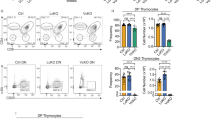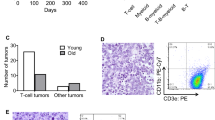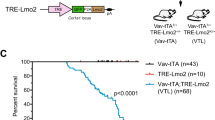Abstract
Phosphatase and tensin homolog deleted on chromosome 10 (Pten) is a tumor suppressor protein whose loss of lipid phosphatase activity is associated with lymphomagenesis. We made use of the Cre-loxP system to delete Pten expression in Lck- or CD4-expressing T-lineage cells. Mice initially showed modest thymic hyperplasia and subsequently developed expanding and infiltrating T-cell lymphomas, leading to a premature death within 5 to 23 weeks. Frequently, all thymocyte and peripheral T-cell populations displayed phenotypes characteristic for immature developing thymocyte precursors and shared elevated levels of clonally rearranged T-cell receptor (TCR) β chains. In concert, CD2, CD5, CD3ɛ and CD44, proteins associated with increased expression and signaling capacity of both the immature pre-TCR and the mature αβTCR, were more abundantly expressed, reflecting a constitutive state of activation. Although most T-cell lymphomas had acquired the capability to infiltrate the periphery, not all populations left the thymus and expanded clonally exclusively in the thymus. In line with this, only transplantation of thymocytes with infiltrating capacity gave rise to T-cell lymphoma in immunodeficient recipients. These results indicate that T-cell-specific Pten deletion during various stages of thymocyte development gives rise to clonally expanding T-cell lymphomas that frequently infiltrate the periphery, but originate in the thymus.
This is a preview of subscription content, access via your institution
Access options
Subscribe to this journal
Receive 12 print issues and online access
$259.00 per year
only $21.58 per issue
Buy this article
- Purchase on Springer Link
- Instant access to full article PDF
Prices may be subject to local taxes which are calculated during checkout






Similar content being viewed by others
References
Cantrell DA . Phosphoinositide 3-kinase signalling pathways. J Cell Sci 2001; 114 (Part 8): 1439–1445.
Pallard C, Stegmann AP, van Kleffens T, Smart F, Venkitaraman A, Spits H . Distinct roles of the phosphatidylinositol 3-kinase and STAT5 pathways in IL-7-mediated development of human thymocyte precursors. Immunity 1999; 10: 525–535.
Williams JA, Hathcock KS, Klug D, Harada Y, Choudhury B, Allison JP et al. Regulated costimulation in the thymus is critical for T cell development: dysregulated CD28 costimulation can bypass the pre-TCR checkpoint. J Immunol 2005; 175: 4199–4207.
Suzuki A, Yamaguchi MT, Ohteki T, Sasaki T, Kaisho T, Kimura Y et al. T cell-specific loss of Pten leads to defects in central and peripheral tolerance. Immunity 2001; 14: 523–534.
Deane JA, Fruman DA . Phosphoinositide 3-kinase: diverse roles in immune cell activation. Annu Rev Immunol 2004; 22: 563–598.
Alessi DR, James SR, Downes CP, Holmes AB, Gaffney PR, Reese CB et al. Characterization of a 3-phosphoinositide-dependent protein kinase which phosphorylates and activates protein kinase B alpha. Curr Biol 1997; 7: 261–269.
Sarbassov DD, Guertin DA, Ali SM, Sabatini DM . Phosphorylation and regulation of Akt/PKB by the rictor-mTOR complex. Science 2005; 307: 1098–1101.
Inoki K, Li Y, Zhu T, Wu J, Guan KL . TSC2 is phosphorylated and inhibited by Akt and suppresses mTOR signalling. Nat Cell Biol 2002; 4: 648–657.
Barata JT, Silva A, Brandao JG, Nadler LM, Cardoso AA, Boussiotis VA . Activation of PI3K is indispensable for interleukin 7-mediated viability, proliferation, glucose use, and growth of T cell acute lymphoblastic leukemia cells. J Exp Med 2004; 200: 659–669.
Ozes ON, Mayo LD, Gustin JA, Pfeffer SR, Pfeffer LM, Donner DB . NF-kappaB activation by tumour necrosis factor requires the Akt serine-threonine kinase. Nature 1999; 401: 82–85.
Kim K, Lee CK, Sayers TJ, Muegge K, Durum SK . The trophic action of IL-7 on pro-T cells: inhibition of apoptosis of pro-T1, -T2, and -T3 cells correlates with Bcl-2 and Bax levels and is independent of Fas and p53 pathways. J Immunol 1998; 160: 5735–5741.
Offner F, Plum J . The role of interleukin-7 in early T-cell development. Leuk Lymphoma 1998; 30: 87–99.
Rodewald HR, Waskow C, Haller C . Essential requirement for c-kit and common gamma chain in thymocyte development cannot be overruled by enforced expression of Bcl-2. J Exp Med 2001; 193: 1431–1437.
Ciofani M, Zuniga-Pflucker JC . Notch promotes survival of pre-T cells at the beta-selection checkpoint by regulating cellular metabolism. Nat Immunol 2005; 6: 881–888.
Taghon T, Yui MA, Pant R, Diamond RA, Rothenberg EV . Developmental and molecular characterization of emerging beta- and gammadelta-selected pre-T cells in the adult mouse thymus. Immunity 2006; 24: 53–64.
Mallick CA, Dudley EC, Viney JL, Owen MJ, Hayday AC . Rearrangement and diversity of T cell receptor beta chain genes in thymocytes: a critical role for the beta chain in development. Cell 1993; 73: 513–519.
von Boehmer H, Aifantis I, Feinberg J, Lechner O, Saint-Ruf C, Walter U et al. Pleiotropic changes controlled by the pre-T-cell receptor. Curr Opin Immunol 1999; 11: 135–142.
Hayes SM, Shores EW, Love PE . An architectural perspective on signaling by the pre-, alphabeta and gammadelta T cell receptors. Immunol Rev 2003; 191: 28–37.
Mao C, Tili EG, Dose M, Haks MC, Bear SE, Maroulakou I et al. Unequal contribution of Akt isoforms in the double-negative to double-positive thymocyte transition. J Immunol 2007; 178: 5443–5453.
Gomez M, Tybulewicz V, Cantrell DA . Control of pre-T cell proliferation and differentiation by the GTPase Rac-I. Nat Immunol 2000; 1: 348–352.
Azzam HS, Grinberg A, Lui K, Shen H, Shores EW, Love PE . CD5 expression is developmentally regulated by T cell receptor (TCR) signals and TCR avidity. J Exp Med 1998; 188: 2301–2311.
Maehama T, Dixon JE . The tumor suppressor, PTEN/MMAC1, dephosphorylates the lipid second messenger, phosphatidylinositol 3,4,5-trisphosphate. J Biol Chem 1998; 273: 13375–13378.
Suzuki A, de la Pompa JL, Stambolic V, Elia AJ, Sasaki T, del Barco Barrantes I et al. High cancer susceptibility and embryonic lethality associated with mutation of the PTEN tumor suppressor gene in mice. Curr Biol 1998; 8: 1169–1178.
Di Cristofano A, Kotsi P, Peng YF, Cordon-Cardo C, Elkon KB, Pandolfi PP . Impaired Fas response and autoimmunity in Pten+/− mice. Science 1999; 285: 2122–2125.
Yilmaz OH, Valdez R, Theisen BK, Guo W, Ferguson DO, Wu H et al. Pten dependence distinguishes haematopoietic stem cells from leukaemia-initiating cells. Nature 2006; 441: 475–482.
Podsypanina K, Ellenson LH, Nemes A, Gu J, Tamura M, Yamada KM et al. Mutation of Pten/Mmac1 in mice causes neoplasia in multiple organ systems. Proc Natl Acad Sci USA 1999; 96: 1563–1568.
Uddin S, Hussain A, Al-Hussein K, Platanias LC, Bhatia KG . Inhibition of phosphatidylinositol 3′-kinase induces preferentially killing of PTEN-null T leukemias through AKT pathway. Biochem Biophys Res Commun 2004; 320: 932–938.
Hagenbeek TJ, Naspetti M, Malergue F, Garcon F, Nunes JA, Cleutjens KB et al. The loss of PTEN allows TCR alphabeta lineage thymocytes to bypass IL-7 and Pre-TCR-mediated signaling. J Exp Med 2004; 200: 883–894.
Lee PP, Fitzpatrick DR, Beard C, Jessup HK, Lehar S, Makar KW et al. A critical role for Dnmt1 and DNA methylation in T cell development, function, and survival. Immunity 2001; 15: 763–774.
Marino S, Krimpenfort P, Leung C, van der Korput HA, Trapman J, Camenisch I et al. PTEN is essential for cell migration but not for fate determination and tumourigenesis in the cerebellum. Development 2002; 129: 3513–3522.
Gu H, Marth JD, Orban PC, Mossmann H, Rajewsky K . Deletion of a DNA polymerase beta gene segment in T cells using cell type-specific gene targeting. Science 1994; 265: 103–106.
Kirberg J, Berns A, von Boehmer H . Peripheral T cell survival requires continual ligation of the T cell receptor to major histocompatibility complex-encoded molecules. J Exp Med 1997; 186: 1269–1275.
Gimeno R, Weijer K, Voordouw A, Uittenbogaart CH, Legrand N, Alves NL et al. Monitoring the effect of gene silencing by RNA interference in human CD34+ cells injected into newborn RAG2−/− gammac−/− mice: functional inactivation of p53 in developing T cells. Blood 2004; 104: 3886–3893.
Wiernik PH . HTLV-associated T-cell lymphoma and leukemia. In: Wiernik PH, Goldman JM, Dutcher JP, Kyle RA (eds). Neoplastic Diseases of the Blood, 4th edn. Cambridge University Press, The Edinburgh Building: Cambridge, UK, 2003, pp 156.
Naor D, Sionov RV, Ish-Shalom D . CD44: structure, function, and association with the malignant process. Adv Cancer Res 1997; 71: 241–319.
Rochman M, Moll J, Herrlich P, Wallach SB, Nedvetzki S, Sionov RV et al. The CD44 receptor of lymphoma cells: structure-function relationships and mechanism of activation. Cell Adhes Commun 2000; 7: 331–347.
Zahalka MA, Okon E, Gosslar U, Holzmann B, Naor D . Lymph node (but not spleen) invasion by murine lymphoma is both CD44− and hyaluronate-dependent. J Immunol 1995; 154: 5345–5355.
Geissinger E, Bonzheim I, Krenacs L, Roth S, Strobel P, Ott G et al. Identification of the tumor cells in peripheral T-cell lymphomas by combined polymerase chain reaction-based T-cell receptor beta spectrotyping and immunohistological detection with T-cell receptor beta chain variable region segment-specific antibodies. J Mol Diagn 2005; 7: 455–464.
Sawada S, Scarborough JD, Killeen N, Littman DR . A lineage-specific transcriptional silencer regulates CD4 gene expression during T lymphocyte development. Cell 1994; 77: 917–929.
Na SY, Patra A, Scheuring Y, Marx A, Tolaini M, Kioussis D et al. Constitutively active protein kinase B enhances Lck and Erk activities and influences thymocyte selection and activation. J Immunol 2003; 171: 1285–1296.
Borlado LR, Redondo C, Alvarez B, Jimenez C, Criado LM, Flores J et al. Increased phosphoinositide 3-kinase activity induces a lymphoproliferative disorder and contributes to tumor generation in vivo. FASEB J 2000; 14: 895–903.
Webb LM, Vigorito E, Wymann MP, Hirsch E, Turner M . Cutting edge: T cell development requires the combined activities of the p110gamma and p110delta catalytic isoforms of phosphatidylinositol 3-kinase. J Immunol 2005; 175: 2783–2787.
Swat W, Montgrain V, Doggett TA, Douangpanya J, Puri K, Vermi W et al. Essential role of PI3Kdelta and PI3Kgamma in thymocyte survival. Blood 2006; 107: 2415–2422.
Hernandez-Hoyos G, Sohn SJ, Rothenberg EV, Alberola-Ila J . Lck activity controls CD4/CD8 T cell lineage commitment. Immunity 2000; 12: 313–322.
Rodriguez-Borlado L, Barber DF, Hernandez C, Rodriguez-Marcos MA, Sanchez A, Hirsch E et al. Phosphatidylinositol 3-kinase regulates the CD4/CD8 T cell differentiation ratio. J Immunol 2003; 170: 4475–4482.
Malstrom S, Tili E, Kappes D, Ceci JD, Tsichlis PN . Tumor induction by an Lck-MyrAkt transgene is delayed by mechanisms controlling the size of the thymus. Proc Natl Acad Sci USA 2001; 98: 14967–14972.
Freeman D, Lesche R, Kertesz N, Wang S, Li G, Gao J et al. Genetic background controls tumor development in PTEN-deficient mice. Cancer Res 2006; 66: 6492–6496.
Trotman LC, Pandolfi PP . PTEN and p53: who will get the upper hand? Cancer Cell 2003; 3: 97–99.
Maehama T, Taylor GS, Dixon JE . PTEN and myotubularin: novel phosphoinositide phosphatases. Annu Rev Biochem 2001; 70: 247–279.
Avellino R, Romano S, Parasole R, Bisogni R, Lamberti A, Poggi V et al. Rapamycin stimulates apoptosis of childhood acute lymphoblastic leukemia cells. Blood 2005; 106: 1400–1406.
Voll RE, Jimi E, Phillips RJ, Barber DF, Rincon M, Hayday AC et al. NF-kappa B activation by the pre-T cell receptor serves as a selective survival signal in T lymphocyte development. Immunity 2000; 13: 677–689.
Vilimas T, Mascarenhas J, Palomero T, Mandal M, Buonamici S, Meng F et al. Targeting the NF-kappaB signaling pathway in Notch1-induced T-cell leukemia. Nat Med 2007; 13: 70–77.
Acknowledgements
We thank Christian W Siebel and Charles Kaplan for critically reading the paper and for helpful discussions, Eric Noteboom, Anita Pfauth and Berend Hooijbrink for maintenance of the flow cytometry facilities, Kees Weijer, Jenny M Meerding, Marianne Naspetti and the staff of the animal facilities for animal care and technical assistance, Dimitry Danilenko for histological and immunohistochemical analyses and Carolyn Behrendt for statistical analyses.
Author information
Authors and Affiliations
Corresponding author
Rights and permissions
About this article
Cite this article
Hagenbeek, T., Spits, H. T-cell lymphomas in T-cell-specific Pten-deficient mice originate in the thymus. Leukemia 22, 608–619 (2008). https://doi.org/10.1038/sj.leu.2405056
Received:
Accepted:
Published:
Issue Date:
DOI: https://doi.org/10.1038/sj.leu.2405056
Keywords
This article is cited by
-
PTEN checkMAITs type-17 innate-like T cells
Nature Cell Biology (2022)
-
PTEN directs developmental and metabolic signaling for innate-like T cell fate and tissue homeostasis
Nature Cell Biology (2022)
-
Molecular Insights Into Pathogenesis of Peripheral T Cell Lymphoma: a Review
Current Hematologic Malignancy Reports (2018)
-
Control of amino acid transport coordinates metabolic reprogramming in T-cell malignancy
Leukemia (2017)
-
Oncogenic PTEN functions and models in T-cell malignancies
Oncogene (2016)



